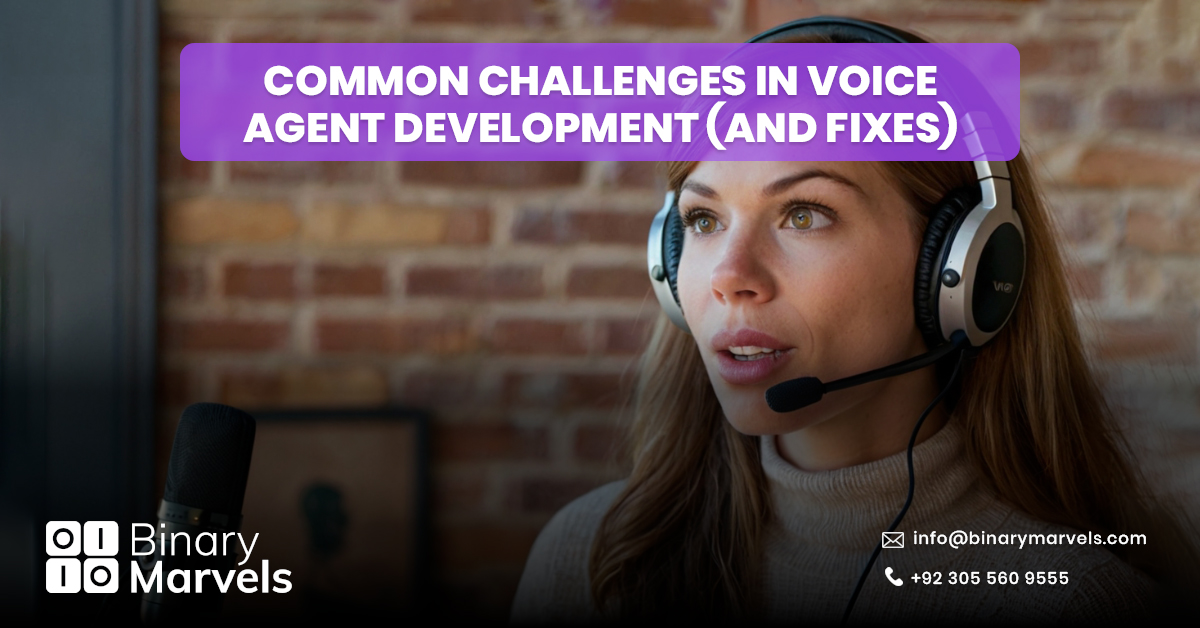
Are you struggling to build a voice agent that actually understands users and works reliably across platforms? You’re not alone. As voice assistants become more common in customer service, smart homes, and mobile apps, developers and businesses face a unique set of technical and user experience challenges.
From speech recognition failures to integration issues, creating a seamless, human-like voice experience isn’t as easy as plugging in an API. It requires careful planning, the right tools, and a solid understanding of natural language processing, audio handling, and user interaction design.
In this post, we’ll explore the most common challenges in voice agent development and how to fix them. Whether you’re building a custom voice assistant, a contact center bot, or adding voice capabilities to an app, these insights will help you save time, reduce errors, and deliver a better user experience.
Let’s get started.
Also Read: Top 10 AI Companies in Pakistan
1. Inaccurate Speech Recognition
The Problem
One of the biggest hurdles in voice agent development is inaccurate speech recognition. Voice agents often struggle to understand users with different accents, speech speeds, or background noise. This leads to misinterpretations, incorrect responses, and user frustration.
Inconsistent results across devices or environments make it hard to maintain a reliable user experience, especially when your voice bot is customer-facing.
The Fix
To improve speech recognition accuracy:
- Use advanced ASR (Automatic Speech Recognition) engines like Google Cloud Speech-to-Text, Amazon Transcribe, or OpenAI Whisper, which support multiple accents and languages
- Implement background noise reduction and audio preprocessing techniques like acoustic echo cancellation and gain control
- Collect and train on domain-specific voice data to better handle your typical users’ vocabulary and tone
- Continuously evaluate and fine-tune recognition models using real interaction logs
Getting speech recognition right is the first step toward building a voice agent that users can trust and enjoy interacting with.
2. Limited Natural Language Understanding (NLU)
The Problem
Even if your voice agent hears the words correctly, it might still fail to understand what the user actually means. Limited natural language understanding is a common issue that results in irrelevant answers, repeated prompts, or complete breakdowns in the conversation flow.
This happens when the system cannot grasp user intent, context, or variations in phrasing. As a result, users may feel like they’re talking to a machine instead of having a helpful interaction.
The Fix
To improve NLU performance:
- Use reliable NLP frameworks like Dialogflow CX, Rasa, or IBM Watson that support intent recognition and entity extraction
- Train your voice agent on real-world, domain-specific data to handle your users’ unique vocabulary and patterns
- Implement context tracking so the agent remembers previous inputs during multi-turn conversations
- Set up fallback and clarification intents to gracefully handle unrecognized queries
Strong natural language understanding ensures your voice agent can engage users effectively and deliver accurate, relevant responses.
Also Read: Why Voice Agents Outperform Humans on Certain Tasks?
3. Poor Conversational Flow and User Experience
The Problem
A voice agent might have excellent speech recognition and NLU, but if the conversation feels robotic or confusing, users will abandon it quickly. Poor conversational flow is a major reason why many voice assistants fail to keep users engaged.
This includes issues like unnatural pauses, lack of personalization, repetitive responses, or not understanding the user’s emotional tone. These problems break the experience and reduce trust in the voice system.
The Fix
To improve conversational design and user experience:
- Design conversations with natural human patterns in mind, using varied and friendly responses
- Personalize interactions by remembering user preferences and context across sessions
- Add emotional intelligence features like sentiment analysis to adjust tone and replies accordingly
- Use voice personas with natural pacing, intonation, and expressions that match your brand
A smooth and intuitive conversational flow builds user confidence and keeps them coming back.
4. Integration with Backend Systems
The Problem
Even the smartest voice agent is limited if it cannot interact with your backend systems. Many developers struggle to connect voice assistants to databases, CRMs, payment gateways, or third-party APIs.
This lack of integration leads to incomplete conversations, broken workflows, or the inability to perform actions like checking order status or updating customer records.
The Fix
To enable smooth backend integration:
- Use APIs and webhooks to securely connect your voice agent with internal systems and external services
- Design modular architecture so services like authentication, database access, and notifications can scale independently
- Use middleware or integration platforms like Zapier, Integromat, or custom Node.js layers for complex workflows
- Ensure data handling follows security protocols, especially when handling sensitive customer information
A well-integrated voice agent goes beyond answering questions. It performs real tasks, driving real value for your users and business.
Also Read: Voicebot vs Callbot vs AI Voice Agent: Key Differences Explained
5. Latency and Performance Issues
The Problem
When a voice agent takes too long to respond, users get frustrated or assume it’s not working. High latency breaks the natural flow of conversation and makes the interaction feel slow and unresponsive.
Performance problems can stem from large model processing times, poor network connections, inefficient backend calls, or overloaded servers during peak usage.
The Fix
To reduce latency and improve performance:
- Optimize the voice processing pipeline by using lightweight models or caching frequent responses
- Implement asynchronous processing for backend tasks to avoid blocking the voice interaction
- Deploy your voice services using cloud platforms that support auto-scaling like AWS Lambda or Google Cloud Functions
- Consider edge computing or on-device inference for real-time response needs
Fast and responsive voice agents create smoother experiences and encourage continued user engagement.
6. Security and Privacy Concerns
The Problem
Voice agents often handle sensitive information such as personal details, account data, or payment instructions. Without proper security measures, this data can be vulnerable to breaches, leaks, or misuse.
Users are becoming more cautious about how their voice data is collected, stored, and used. Failing to address these concerns can lead to loss of trust and even legal consequences.
The Fix
To ensure voice agent security and privacy:
- Encrypt all voice data both in transit and at rest using strong protocols like TLS and AES
- Implement user authentication and authorization for actions that involve sensitive information
- Follow data protection regulations such as GDPR, HIPAA, or local compliance standards
- Clearly communicate your data usage policies and offer opt-in and opt-out options for voice data collection
Secure and transparent voice agents not only protect user data but also build long-term trust with your audience.
7. Scalability Challenges
The Problem
A voice agent may perform well in early stages, but as user traffic grows, performance can degrade. Systems not built for scale often face issues like delayed responses, failed API calls, and downtime during peak usage.
Scalability becomes even more complex when dealing with multiple languages, channels, and integrations across platforms.
The Fix
To build a scalable voice agent:
- Use cloud-native architectures with auto-scaling features such as Kubernetes, AWS Lambda, or Google Cloud Run
- Implement load balancing and traffic routing to distribute user requests efficiently
- Design stateless services where possible to reduce dependency and improve reliability
- Monitor system performance with real-time alerts to catch issues before they affect users
A scalable voice agent ensures consistent performance and availability no matter how fast your user base grows.
Also Read: The Benefits of Voice AI Agents for Call Centers
8. Cross-Platform Compatibility
The Problem
Many voice agents work well on a single platform but fail to deliver consistent performance across multiple channels such as mobile apps, web interfaces, smart speakers, and IVR systems. This inconsistency can frustrate users and limit the agent’s reach.
Each platform has its own set of requirements, audio constraints, and user behaviors, making it difficult to maintain uniform functionality and quality.
The Fix
To ensure cross-platform compatibility:
- Use voice development frameworks that support multi-channel deployment such as Voiceflow, Twilio, or Dialogflow
- Create platform-specific adaptations while maintaining a shared core logic for consistency
- Test your voice agent thoroughly across all supported devices to catch bugs and performance issues early
- Maintain responsive design for voice UI and adjust content formatting based on the platform’s capabilities
Delivering a consistent voice experience across platforms helps improve engagement and ensures your solution meets users wherever they are.
Bonus Tip: Future-Proof Your Voice Agent
Voice technology is evolving fast. What works today may not be enough tomorrow. Future-proofing your voice agent ensures that it remains relevant, effective, and competitive as user expectations and technologies grow.
How to Stay Ahead
- Use open standards and APIs to make future integrations easier
- Design your architecture to be flexible and modular for updates and upgrades
- Stay informed about advancements in LLMs, speech synthesis, and conversational AI
- Regularly collect user feedback and make data-driven improvements
- Experiment with emerging trends like emotion detection, multilingual support, and generative responses
Voice agents that evolve with technology can continue to deliver value without major rebuilds.
Supercharge Your Business with AI Today!
As a trusted AI Development Company in Pakistan, we deliver cutting-edge AI Development Services designed to streamline your operations and enhance customer engagement.
Don’t wait—connect with us now and take your business to the next level!
Conclusion
Voice agent development comes with unique technical and design challenges. From speech recognition accuracy to system integration and security, each hurdle can impact user experience and business results.
The good news is that every challenge has a practical solution. By following best practices and staying updated with new tools and trends, you can build a voice assistant that is fast, intelligent, secure, and ready to scale.
Need help developing a powerful voice agent? Contact our team for expert guidance and custom solutions tailored to your business.
Also Read: AI Voice Agents for Customer Service: Benefits, Use Cases & Best Practices
FAQs
1. What are the common challenges in voice agent development?
Common challenges in voice agent development include inaccurate speech recognition, limited natural language understanding, poor conversational flow, integration issues, latency, security concerns, scalability problems, and cross-platform compatibility. Each can be addressed with the right tools, design strategies, and optimization techniques.
2. Why is speech recognition so difficult in voice agents?
Speech recognition is challenging due to accents, background noise, speaking speed, and context. Modern ASR engines and audio preprocessing help improve accuracy.
3. How can I make my voice assistant sound more natural?
Use dynamic conversational design, personalize responses, apply sentiment analysis, and choose high-quality voice personas to enhance natural flow.
4. Can a voice agent integrate with my CRM or database?
Yes, voice agents can connect with CRMs or databases through APIs, middleware, or custom backend services to perform real-time tasks.
5. Is it safe to use voice assistants for sensitive data?
Yes, if you implement end-to-end encryption, comply with privacy laws, and secure authentication, voice agents can safely handle sensitive information.
6. How do I make a voice agent work on different platforms?
Use frameworks that support multi-channel deployment and adjust voice experiences for each platform while keeping a consistent core logic.









